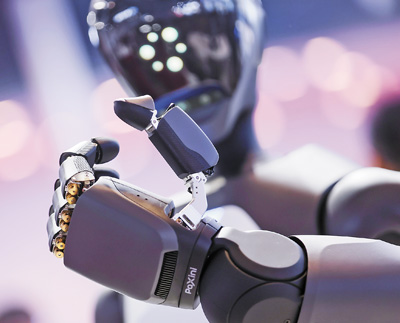




- BRNN
- BRI News
- BRNN News
- Database
Official Documents Polices and Regulations
Inter-government Documents International Cooperation BRI Countries
Business Guide Economic Data BRI Data
Trade
Investment Projects Latest projects
Cases - Content Pool

A robotic hand uses advanced tactile sensors to manipulate objects. (File photo)
Robots powered by embodied artificial intelligence have gained significant traction in recent years, with their ability to physically interact capturing widespread attention. These systems, characterized as intelligence with a physical form, prioritize real-world interaction rather than purely digital capabilities.
Shenzhen, in south China's Guangdong Province, has emerged as a hub for this technology, with approximately 210 companies specializing in embodied AI robotics establishing operations there by the end of 2024.
Robots develop sense of touch to handle delicate objects
Robots developed at PaXini Technology's Shenzhen laboratory can pick up strawberries with remarkable precision, applying just enough pressure to secure the delicate fruit without damaging it.
"Previously, robots could see and hear, but they couldn't feel the world or control their grip strength through touch," said Xu Jincheng, founder and CEO of PaXini Technology.
The company's advances in tactile sensing provide crucial capabilities for robotic systems to interpret physical environments. Each robotic hand contains nearly 1,000 high-precision tactile sensors that collect 15 different data points — including pressure, slippage and texture — upon contact with objects. These sensors demonstrate extraordinary sensitivity, capable of detecting weight differences equivalent to a few grains of rice.

A robot equipped with embodied AI demonstrates clothing-folding capabilities in a lab. (File photo)
Shenzhen's status as a global electronics manufacturing hub provides robotics companies with ready access to vital components, from tactile sensors and LiDAR to servo motors and specialized robotic hands.
"Previously, when we conducted research and development overseas, most components were still shipped from the Guangdong-Hong Kong-Macao Greater Bay Area," Xu noted.
The proximity to suppliers has dramatically shortened PaXini's procurement timeline. "What used to take three months now takes just a week or two," Xu said, adding that shipments of the company's tactile sensors surged in 2024, primarily for use in factory automation systems and humanoid robots.
AI models help robots tackle unpredictable fabrics
Folding clothes poses a greater challenge for robots than lifting heavy boxes because fabric changes shape unpredictably once picked up, complicating both perception and control operations.
X Square Robot, another Shenzhen-based firm, addresses this through embodied large language models that function as an intelligent brain. The company's dual-arm robots can assess fabric deformation in real time and adjust their grip accordingly, efficiently folding scattered clothing with precision.

A four-legged robot patrols during outdoor testing in Shenzhen, south China's Guangdong Province. (File photo)
Wang Qian, founder and CEO of X Square Robot, said embodied models enable robots to perceive, decide and act autonomously, handling complex and delicate tasks with ease.
The robots require no programming or remote control — after just a few demonstrations, they learn to arrange items like cups and plates in various shapes, sizes and orientations, mimicking human intuitive learning.
"In the future, we hope robots can learn from a single observation or even understand instructions and act autonomously," Wang said.
"We're now bringing in global talents and experiencing Shenzhen's strong support and efficient government services," Wang noted. He said in just over a year, the company has completed six rounds of funding, raising hundreds of million yuan.
Autonomous patrol robots reduce security staff workload
At 1 a.m. in Shenzhen's Bao'an district, a four-legged robotic dog emerges from a security room to begin its patrol. Navigating uneven terrain, flower beds and stairs with stability, it inspects hidden corners and identifies potential security risks in a residential community.
"Since deploying the robotic dog, we've reduced human night patrols by four hours," said Yang Yang, deputy general manager of a Shenzhen property services company. "It effectively covers surveillance blind spots and areas inaccessible to wheeled vehicles, especially where stair-climbing capability is needed."
The robot costs more than 300,000 yuan, according to Cao Weijing, founder of Shenzhen FireDog Intelligent Electronics Technology Co., Ltd. Due to the high price point and early-stage adoption, the company offers monthly leases for several thousand yuan rather than outright sales.
"Currently, the robot performs pre-programmed patrols without human input, but cannot yet respond to commands," Yang said. "We hope future versions will operate via voice instructions."
Shenzhen is increasingly deploying embodied AI-powered robots across various sectors. While widespread adoption remains distant, pilot programs are accelerating.
The city has opened its urban infrastructure to AI and robotics development across multiple scenarios. Government agencies and state-owned enterprises are providing real-world testing environments for applications in sanitation, emergency response, health care and eldercare.
Manufacturers are meanwhile providing testing opportunities in factory settings like quality control, production lines and logistics operations, helping companies commercialize robotics technology faster for both industrial and consumer applications.

Tel:86-10-65363107, 86-10-65368220, 86-10-65363106